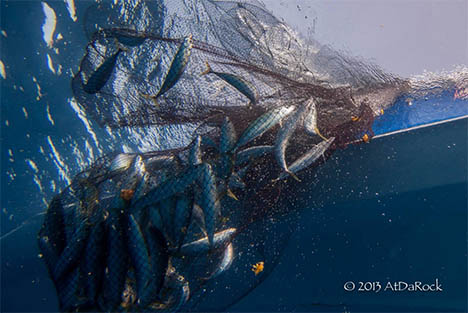10/13/22 – ʻŌpelu Caretaking – Preserving Traditional Fishing in South Kona

Harvesting ʻōpelu. Photo credit Kary Jones-Cox and Paul Cox
By Chris Teague, West Hawaii District Biologist
It’s a clear morning in South Kona and the sun is just starting to peek over the southern slope of Mauna Loa. The ocean is calm and there’s a slight breeze coming over the island from the East. A nice day to be out on the water. Fishers from the village of Miloliʻi have already been up for hours, preparing for the day’s work. Nobody anticipates bringing home a big haul today, but that doesn’t douse anyone’s spirits. Today isn’t about bringing home fish. Today is meant for hānai koʻa, or feeding the fishing grounds.
ʻŌpelu fishing has been a staple of South Kona fishing communities for generations. This small, tasty fish, also called mackerel scad, is an important source of food, bait, and income for many in South Kona. The techniques used by these fishers were developed through centuries of careful observation in order to sustain the fishery for future generations. Proper management, as practiced by fishers within these communities, goes far beyond simply where and when to catch ʻōpelu.
Central to traditional ʻōpelu fishing are the koʻa (fishing grounds). Families harvest at particular koʻa and are responsible for maintaining and managing them to make sure they can produce fish reliably. The exact locations of these grounds, in addition to the proper ways of managing them, are passed down through the generations from kūpuna to keiki. Young fishers are taught how to find the koʻa using natural landmarks, how to feed the ʻōpelu in their koʻa, and how much to harvest to keep the fishery sustainable.
Hawaiian fishers have also long relied on spawning seasons to help dictate when fish should be taken. The spawning season for ʻōpelu runs from around February/March through August. During this time, fishers refrain from harvesting and instead practice hānai, where fishers travel to their koʻa to feed the ʻōpelu. By feeding them regularly, fishers keep the ʻōpelu well-provisioned and returning to the koʻa. Then when it comes time to fish, they are healthy, abundant, and ready for harvest.
In some South Kona fishing villages like Miloliʻi and Hoʻokena, ʻōpelu are fed palu (bait) made from avocado, papaya, taro, and pumpkin. Vegetable-based palu is used by these fishers due to concerns that fish or other animal baits will attract large predators that can drive away the ʻōpelu schools and make the catch less reliable. Communities to the north have a practice that includes adding animal protein to the vegetable-based palu.
Regardless of which type of bait is used by a given fisher, it is important to know and follow the customary practices of each place. These communities depend on the reliability and predictability of their koʻa and altering techniques in the area could disrupt this. The use of vegetable palu is already codified in Hawaiʻi Administrative Rules where the use of fish or animal bait is prohibited for net-based ʻōpelu fishing from Kiʻilae Bay in the north to the Kapuʻa-Kaulanamauna boundary in the south. Additional protections were recently signed into law for the Miloliʻi Community Based Subsistence Fishing Area (CBSFA), including gear restrictions within an ʻŌpelu Traditional Management Zone during the spawning season from February through August.
By following these fishing rules, we can help ensure that these important fishing traditions will endure while also ensuring that the fishers who have chosen to ‘auamo (carry) the kuleana (responsibility) of continuing those traditions can keep feeding themselves and their communities for years, decades, and generations to come.
Additional resources:
- South Kona ʻōpelu management zone: https://dlnr.hawaii.gov/dar/fishing/fishing-regulations/regulated-areas/regulated-fishing-areas-on-hawaii/#south-kona-milolii
- Regulations within the Miloliʻi Community Based Subsistence fishing Area: https://dlnr.hawaii.gov/dar/fishing/fishing-regulations/regulated-areas/regulated-fishing-areas-on-hawaii/#milolii-community-based-subsistence-fishing-area

Fishers release palu from a bag to feed the ʻōpelu. Photo credit Kary Jones-Cox and Paul Cox
